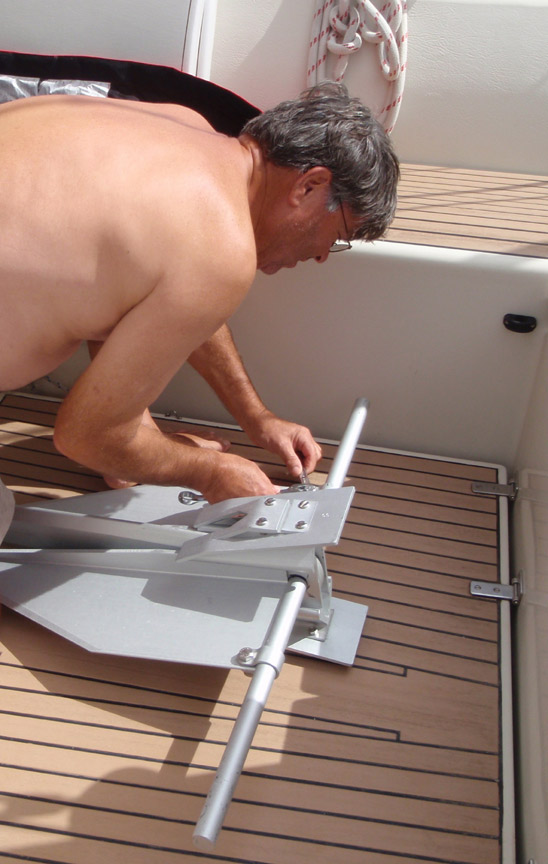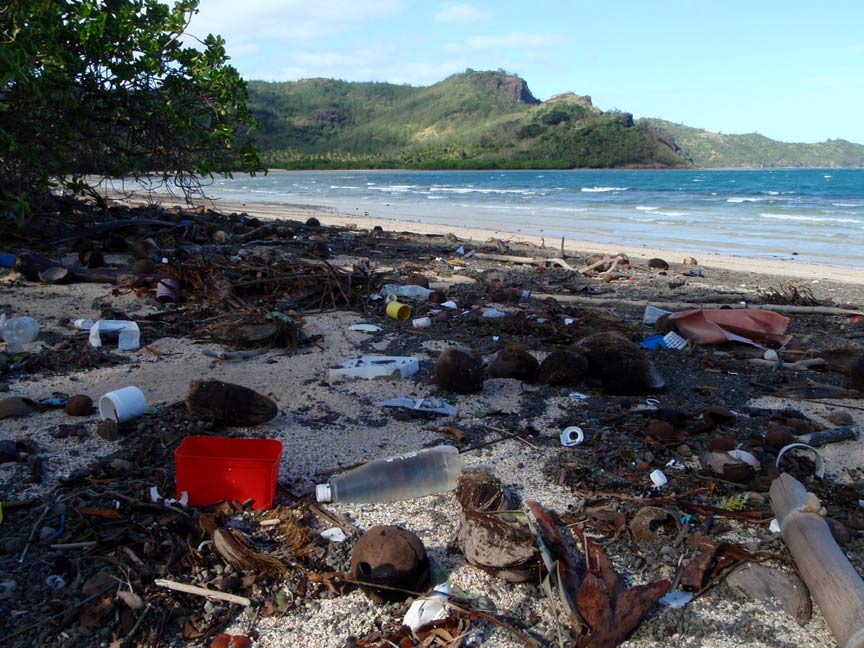Big Wind, Part 2 - Cukuvou Harbor, Yadua Island, Fiji

Harmonie
Don and Anne Myers
Wed 29 Jul 2009 23:08
|
16:49.049S 178:17.022E
Here's the rest of our Yadua Island big wind
saga:
We stayed at Yadua Island for a week. It
wasn't until the fourth day that the wind started to pick up.
We had a sense for what was coming because we are able to get weather
information using the satellite phone when we are in remote places. The
wind was expected to increase to 25-30 knots and remain there for about 48
hours. There was no storm passing through, we were just
in a 'squash zone' between two air masses, which typically means
higher than normal winds for a sustained period of time. Along with Lady
Kay, we decided to stay put and wait out the high winds. On that Tuesday
morning, the other two American sailboats left, leaving the entire bay to Lady
Kay and Harmonie. They left at about 7am. The wind started getting
ugly at 11am. It wasn't more than fifteen minutes before it
zoomed past the expected 25-30 knots and was moving on to an unruly 40
knots with gusts to a scary 45. We wondered how far the two American
boats had gotten before they received their first mighty forty knot
plus blast of wind. As per our usual selfish nature, we congratulated
ourselves on our decision to stay put and were exceedingly glad we weren't out
there sailing in the fray.
It wasn't much longer before it became clear that
the 25-30 knots we expected had been replaced by the 30-40 knot frenzy, and
that the 30-40 knot frenzy was probably going to last the
full two days. This realization caused us to quickly move into
'Anchorage High Wind Precaution Mode', or AHWPM for short (why
not? after all, AHWPM is easier to pronounce than most Fijian island
names). AHWPM requires us to remove any supercilious pieces of equipment
above deck that could cause extra windage (a boater term defined loosely as
stuff on deck that gets in the way of the wind). The first thing to come
down was the sun cover (flapping wildly as we attempted to fold it,
then balled up in a wad when we gave up and chucked it down into the
cabin), next was our big US flag off the stern and the
clothesline off the bow. AHWPM also requires us to 'batten down the
hatches' as the old salty sea captains used to say (at least they did in
the movies anyway). The windshield was secured shut, as were most
hatches and ports. Since we didn't have time before the wind whipped up to
remove the outboard motor from the back of the dinghy and haul the dinghy
aboard, and it was already too wild out to attempt lifting the
motor or the dinghy, Don added a bridle using heavy dock lines to keep
the dinghy right side up and firmly attached to both big cleats on the back of
the boat (had we lost the dinghy, it would have blown half-way to Vanuatu
by the time the wind died down). And, you may be wondering, what
is the final AHWPM requirement, the keystone of high wind readiness
while at anchor? The Fortress. This is an anchor that we have
carried with us since the beginning of our trip. We bought it new before
leaving the US and hadn't used it once. Until now. Out it came from
its storage spot deep in the bow cabin's hanging locker (under the canvas
bags, rolled up salon rug and the mini ironing board - the only other piece
of equipment on the boat used less often than The Fortress). Out into the
cockpit The Fortress went, where Don unpacked it and completed the
required assembly.
Picture 1 - Don working feverishly to complete
assembly of The Fortress.
Once ready for deployment, we launched The
Fortress overboard off the bow, such that the angle formed by its line and
that of our main anchor's was about thirty degrees. To do this, I motored
the boat forward into the blasting wind, until we reached a point parallel
to the location of our main anchor; which by the way, was still holding strong
even in the 45 knot gusts. Once there, Don heaved The Fortress over
the bow rail, I then shifted the engine into neutral and the boat zoomed
backward with the force of the wind. It was good Don wasn't standing in
the middle of the pile of chain and line attached to The Fortress because
once The Fortress was overboard and the boat started zooming backward,
the twenty meters of chain and thirty meters of line literally flew
off the bow (except, of course, for the end, which was attached to a
cleat). Lady Kay also deployed a second anchor and by two that
afternoon, both boats were standing up nicely to the blasting, buffeting,
roaring wind.
When at anchor in high winds, you can actually
feel the boat straining against the wind and waves. It's true. The
feeling, although a little disconcerting at first, does give you a sense of
security though because you know if you don't feel it then big trouble is
brewing - especially when in a bay ringed with reefs that are beautiful to
look at unless you happen to be on a boat dragging anchor fast in their
direction. So we sat in the bay with the roaring wind, secure in our
knowledge that both anchors were working hard to keep the straining boat in one
place. At that point the only thing left to do was wait. We couldn't
leave the boat because it was too dangerous to venture out in the
dinghy. So we waited. Marooned on our boat with no radio, TV,
phone or internet. Not that we ever have these things when visiting remote
islands, but their absence becomes more noticeable when the weather is bad and
getting off the boat is not an option. So what's left to do? I opted
for baking. We had about fifty bananas
donated to us by Storyteller about a week earlier and the twenty-five
that were left were nearing the black mush stage in a big
way. Several batches of banana bread and muffins later and that problem
was solved. Now our big-eating 23-year old nephew can be stationed up on
the bow with a stalk of bananas, a tub of mahi-mahi and a basket of muffins for
his first couple of days aboard in Vanuatu. Don opted for reading,
and got through at least two books over the course of the big
wind.
Later on in the afternoon of the
first big wind day, we received a radio call from Windchase, a small Dutch
sailboat we had met briefly in Tonga. At the time, they didn't know we
were in the bay, and they put out a general call to any yacht in the Yadua
Island vicinity. We answered their call and they explained that they were
enroute from Vanua Levu, passing by the east side of Yadua Island and
experiencing 50 knot winds. It was at this point that we stopped feeling
sorry for ourselves and realized the island really was providing some protection
for us since we were only seeing winds as high as 35 and 40 by that time.
Not to mention the fact that we were sitting semi-comfortably at anchor(s) while
they were being tossed by the waves and blown nearly over by 50 knots of
wind as they sailed. We explained where we were anchored to Windchase and
they indicated that they would sail directly to our location. Several
hours later, just as the sun began to set, we spotted the small, violently
bouncing Windchase on the horizon, rounding the northwest corner
of Yadua. They continued on around to the west side, struggled for a
good twenty minutes to get their sails down, turned into the bay (and into the
wind) and attempted to motor between the reefs lining the bay
entrance. We watched and held our breath. 'Are they moving?'
'Are they on the reef?' 'What if they call mayday?' 'Should I get
the life jackets ready to go in the dinghy?' These were all the
questions we were asking ourselves as Don and I and Michael and Jackie watched
intently from our respective boats. Just as the sun dipped below the
horizon, it became clear that Windchase had given up, put their sails back up,
and had turned downwind back out to sea. About ten minutes later they
radioed to say their small engine just couldn't power them into the 40 knot wind
and since sailing into the bay was not an option (too narrow a passage
through the too many reefs), they had decided to head back out to sea where they
would heave-to until morning. As sleepless as I was until two in
the morning that night, I again selfishly admitted that I was really
glad it wasn't us out there on the open water, drifting in
ferocious winds and waves, trying to sleep.
The next day the winds were down a
smidgen so we decided to brave the elements and take the dinghy to
shore where we could go for a walk on the sheltered beach and therefore
ward off the cabin fever that was looming around the edges of our marooned
selves. On the beach it was hard to believe that only a
short distance out into the bay existed a completely different world filled with
howling wind. We reveled in the silence of the quiet beach where only our
footprints marked the sand, but in the end, had to climb back into the
dinghy and return to the world of wind. Another windy night and
by noon the next day the wind relented to a more civilized 20-25 knots. We
took the dinghy ashore again (still too rough to swim or snorkel) and climbed
over the ridge that separates Cukuvou Harbor with the neighboring bay to
the south. We arrived on the windy beach at low tide and got an eyeful of
the flotsam and jetsam that had blown onto the exposed shore with the
accelerated winds. There was a variety of trash, but the number of wayward
flip-flops was what surprised us. The number of lost flip-flops
almost equaled that of the ubiquitous plastic bottles. We decided the
array of trash must have blown across the Bligh Water from the big island
of Viti Levu to the south. Somebody, or a whole bunch of somebodies on
Viti Levu must be wondering where they put their flip-flops.
Picture 2 - Our brief respite from the wind on
the protected, calm and quiet beach.
Picture 3 - The flotsam and jetsam piled on the
windward beach over the ridge to the south of our quiet beach.
There was still plenty of wind and the white-capped rollers were presumably
still smuggling in plastic bottles, innocent flip-flops and other bits and
pieces stolen off the coast of Viti Levu Island to the
south.
We did hear from Windchase on that second
day. They survived the first night hove-to and in the morning found an
adequate bay on the northern side of Yadua. They rested there and when we
and Lady Kay left Yadua on Friday, July 24th in a very reasonable 20 knot
easterly wind, we spotted Windchase rounding the corner to head into the bay we
had just left. This time they made it in.
That about sums up our adventures in Cukuvou Harbor
on Yadua Island.
More on our travels along the north coast of Viti
Levu and its outlying islands and reefs later.
Anne |


